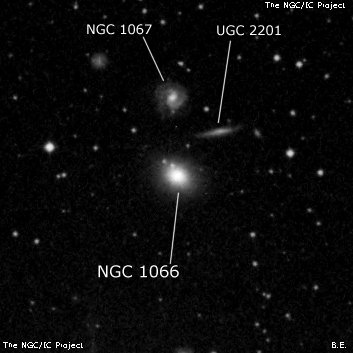
William Herschel discovered NGC 1066 = H III-163 = h260, along with NGC 1060, on 12 Sep 1784 (sweep 268) and described both as "Two, both vF, pS, R lbM." The galaxy was observed 10 times at Birr Castle!
400/500mm - 17.5" (11/27/92): faint, moderately large, slightly elongated N-S, 1.5'x1.3'. Similar size to NGC 1060 8' WSW but one magnitude fainter. Broadly concentrated halo but no well defined core. Located 7' NNW of mag 7.7 SAO 55822. Forms a pair with NGC 1067 2.2' N, also nearby is NGC 1061 7' W. Appears brighter than the CGCG mag of 14.9.
600/800mm - 24" (9/23/17): at 260x; fairly bright, large, slightly elongated, well concentrated with a bright core and low surface brightness halo ~1.5'x1.2'. A mag 7.4 star (HD 16954) lies 7' SSE. NGC 1066 is the second brightest member of the NGC 1060 group = WBL 85, with NGC 1067 2.2' N.
24" (2/7/16): moderately to fairly bright, moderately large, slightly elongated SW-NE, 1.3'x1.0', well concentrated core increases to the center, occasional faint stellar nucleus. Second brightest and largest in the cluster (WBL 085). In a small trio with NGC 1067 2.2' N and UGC 2201 1.7' NW. UGC 2201, which is misidentified as NGC 1062 in RNGC, RC3 and SIMBAD, is an extremely low surface brightness edge-on and was only occasionally glimpsed, extending ~30"x10" E-W. UGC 2202, situated 5.1' S, appeared very faint, small, round, low even surface brightness, 18" diameter. A mag 13 star is 0.8' W. This dwarf irregular is located just 2.8' NW of mag 7.4 HD 16954 and it helped to place the star just outside the field. MCG +05-07-046 is 10.6' SE and 5' ESE of the bright star. It appeared very faint, fairly small, oval 2:1 E-W, 25"x14", low surface brightness, no concentration.
Notes by Steve Gottlieb